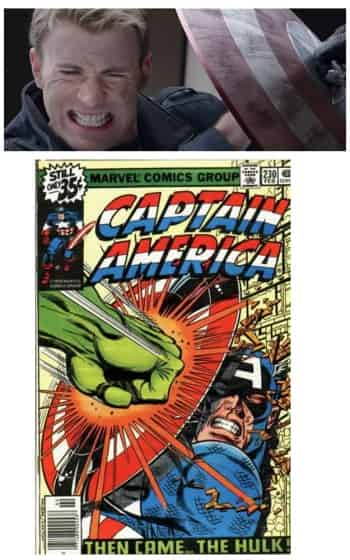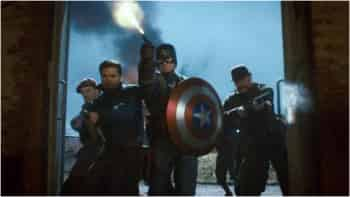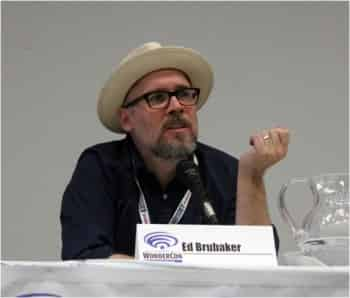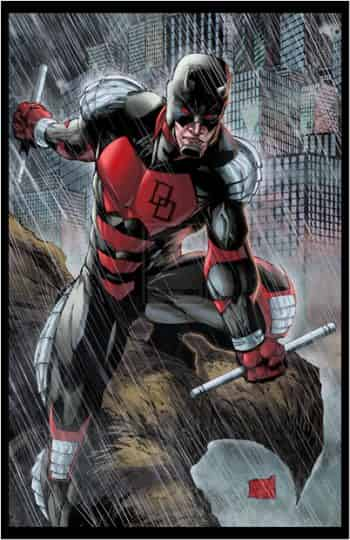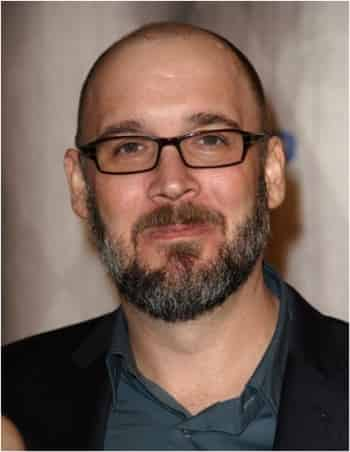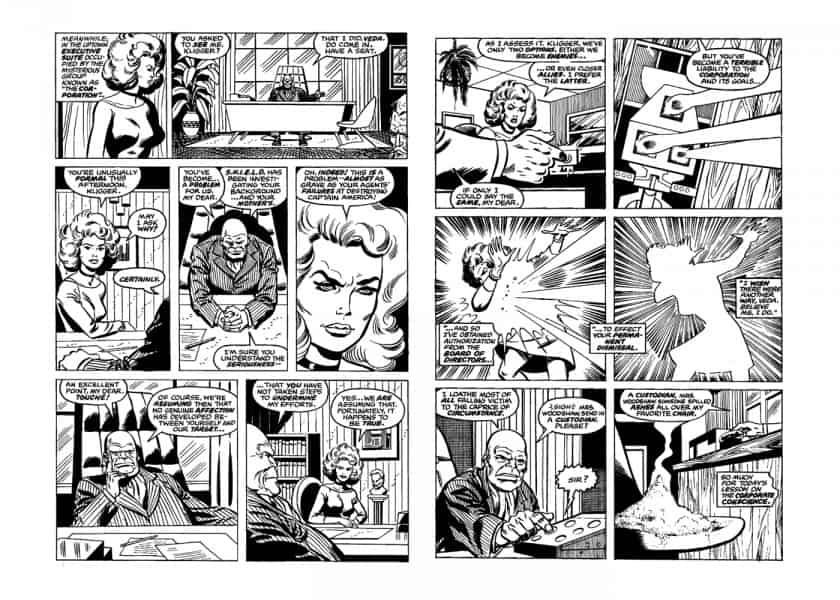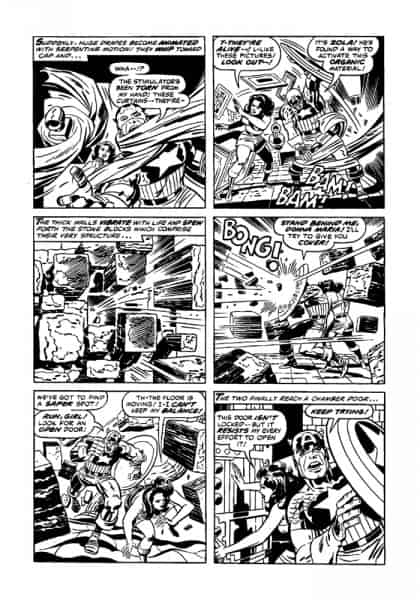
Captain America
Characters drive comicbooks
Recently, we found this analysis by Ed Campbell, pointing out that big comicbook editors (Marvel or DC) haven’t been able to create as many characters in recent years as they had in previous decades.
But does creator’s rights make the comic book industry stale? Or does it only affect the “big 2″ comic publishers, while smaller publications thrive?
If you look at Marvel and DC over the past decade, there haven’t been too many new characters come out for the comics. There were some characters who were “re-imagined” when DC launched the New 52. But on the most part there haven’t been any characters to really jump off the page and become household names. Even Marvel has introduced some new characters like Ghost Rider, Nova and Ms. Marvel. But they are just older characters with new characters portraying these long-time Marvel personas. (“Creator’s Rights = Stale Creativity,” www.comicbookdaily.com, June 20, 2014).
To find proof of this stagnation in character development, one need only think of Mark Gruenwald, who invented dozens of characters—some of them quite memorable—during his time on Captain America. There’s no sense of such a rich creative vein being tapped nowadays. New characters allow heroes to face new experiences and new adversaries that multiply fans’ reading pleasure.
Are superheroes fascist?
Faraci revisits the oft-touted argument that superheroes are fascist: “Superheroes are essentially fascist because they use force to accomplish their goals, and their goals are almost always supporting and protecting the status quo.” (David Faraci, “Are Super-heros Fascist?” December 1, 2013, http://badassdigest.com.). The status quo is more than bearable if the superhero is a multi-millionaire, but then we may wonder whether the hero is acting for the benefit of others or to preserve his or her own social standing?
The latest Captain America, The Winter Soldier, offers a counter-argument to this opinion. The shield bearer doesn’t stop at defeating the bad guys’ plot, he also destroys his employer, Shield, which he feels has become too corrupt to pursue its mission. It should be noted that Cap’s altruism is his trademark.
Interpreting Captain America
We’ve confessed it before and we’ll say it again: Captain America was (is still) our favourite superhero. When we saw the first movie Marvel dedicated to him, we felt uncomfortable seeing him holding a gun, but we couldn’t quite figure out why. Then we came across this interpretation by Chris Sims. We totally agree with his analysis:
“One of the things I really like about this story is how much importance Kirby puts onto the idea of Cap’s shield as a symbol. I love that, because it underscores one of my favorite things about the character: He’s a soldier who doesn’t carry a gun. He carries a shield, because he exists to protect and defend people against the forces that would hurt them. It’s one of the most elegant ideas in comics, and something that I think really plays into Kirby’s idealized vision of what America should be […] It’s a big symbol, and in Cap’s view—and Kirby’s—that symbol has a lot of power. “(Chris Sims, “Ask Chris #156: KILL-DERBY!” July 5, 2013, http://comicsalliance.com.)
Reading this, we wonder if the creators had all those ideas explicitly, or if these concepts were unconscious and only waiting to emerge. The second Captain America movie (“The Winter Soldier”) was much more consistent with this definition of Cap’s character.
Making a plan and being able to deviate from it – Part I
At the end of his time at Marvel, where he mainly worked on the Captain America series, Ed Brubaker said the following: “I hoped for two years, and planned for three, because three years was about the longest I’d stayed on any other book. My pitch document had the first 12 issues mapped out, which I mostly stuck to, actually, and then sketched out the next year in broad strokes. I never imagined I’d go even 50 issues, let alone the I think 102 issues I did, counting mini-series and one-shots and annuals.” He also added, “More than anything, it was that each issue kept wanting to be longer or I kept feeling like I had more ideas and wanted to spend more time with the characters, and realized I was stopping myself from doing that with an arbitrary structure I’d imposed on myself” (“The Ed Brubaker ‘Captain America’ Exit Interview,” David Brothers, comicsalliance.com, November 1, 2012).
There are two opposing ideas here: the idea of a plan that guides the author, and the idea of the flexibility the writer must maintain to include new ideas or developments that hadn’t been originally anticipated. In our project, one of the ideas that just evolved like that was Votan’s identity. At first, he was going to remain mysteriously anonymous over a number of stories, if not all the way to the end, but ultimately, we dropped that concept, preferring instead to reveal his identity quickly, because this opened up more dramatic opportunities.
Event Creation
As we have said in the past, changing authors is often used as a way to boost sales for a series. But a new author isn’t always enough and so an event must be created. Chichester admitted as much in an interview where he explained that the change in Daredevil’s costume in the early 1990s was a way to attract readers’ attention to the series and to position other changes in tone that they wanted to introduce (“Interview With D.G. Chichester (February 1998),” www.manwithoutfear.com).
However, these media events are now often clichéd. Readers know very well that the death of a major character is only a momentary eclipse to prepare their return. Like Graeme McMillan said: “It doesn’t help that it’s War in these teasers, a word that has similar weight at Marvel as “Crisis” does for DC. Between Secret War, Ultimate War, Civil War, Silent War, Chaos War and countless other wars that I’ve probably forgotten about (Oh! War of Kings, of course), the word has become almost meaningless in its attempt to suggest epic bombast, just like… Well, like the sight of Cap’s shield either cracked or splattered with blood, really. There’s an amazing sense of déjà vu from these trailers that’s unfortunate, especially considering that Avengers Vs. X-Men was already treading in ‘Haven’t I seen superheroes punching each other a lot recently in Civil War and X-Men: Schism?’ waters” (“I Don’t Wanna Live a War That’s Got Not End in Our Time,” www.newsarama.com, June 26, 2012).
On Tone
When Spurgeon interviewed Ed Brubaker (“CR Sunday Interview: Ed Brubaker,” www.comicsreporter.com, June 24, 2012) he offered this introduction to one of his questions: “When I read a bunch of your Captain America recently, I was surprised how somber it was. I don’t mean that it was depressing or sad, I mean serious and sober.”
We came across this sentence a long time after we’d started writing and we felt that it was in keeping with what we are trying to do. Our dialogue is imbued with restraint—some would even say banality, and we accept that. Our goal isn’t to write transcendent dialogue. Instead we want to convey ambiguous moods, as though the characters were unable to reconcile all the mysteries around them or all the lies they’ve told others and themselves.
The Source of the Consortium Name
The Consortium is strongly inspired by the Corporation, which appeared in Captain America in the late 70s. It consisted of a group of businessmen who were involved in criminal activities to increase their riches and their influence.
The relationship between Kligger and Veda
See the reproduction of a scene published in 1978, in issue 225 of Captain America. We think this scene, written by Steve Gerber, is very nice. It develops and concludes the story in just a few frames. The scene also shows the complex relationships between individuals characters, where the villains are not totally united against their common enemies. These two pages strongly influenced our writing.
What inspired Volcanne’s Island?
We were inspired by Arnim Zola when we created Volcanne, and we drew on his castle to create his island. In issue 211 of Captain America, Jack Kirby transformed a simple castle into a formidable adversary for the Star-Spangled Avenger (see image). We were particularly interested in taking a run-of-the-mill environment and transforming it into something murderous.


